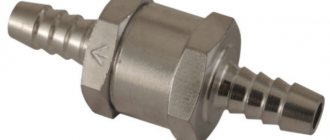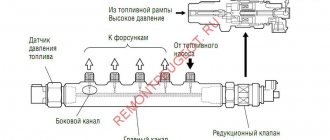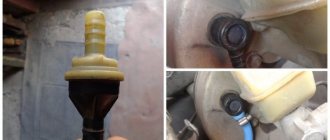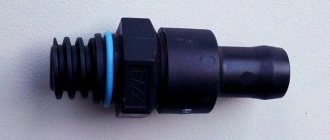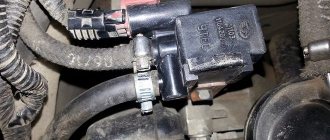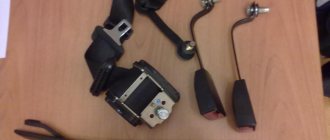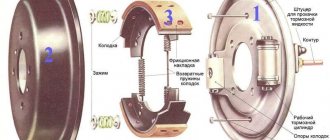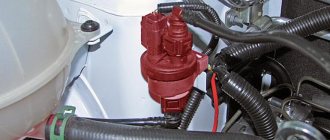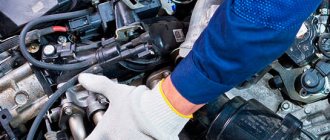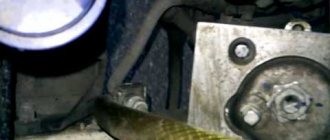Fuel systems of automobile engines are a rather complex device, the approach to which is contraindicated without knowledge of some basic concepts. Knowledge of the equipment and minimal experience are the main components that will help eliminate any malfunction. Even the wheel cannot be taken apart without special ceremony. We need preparation. And the power supply system is a complex set of devices that seem elementary only at first glance.
The photo shows a car fuel system, which should only be repaired by a specialist.
Even the conventional fuel system of the old VAZ 2101 can throw up a trick that modern high-tech engines have never even dreamed of, not to mention diesel engines of the last few years of production, where two electronic fuel sensors are installed for every centimeter of the line. Something as insignificant as a check valve may raise eyebrows among an experienced mechanic, but if the average car enthusiast is talking about a check valve, then it's worth going into more detail.
Where is the fuel check valve located?
Let's find out where the fuel system valve of various cars is located.
- In power plants with an injector, it can be installed in the gasoline pump housing.
- Mounted on the fuel frame or installed directly in the fuel line. This is the space between the gas tank and the fuel injectors.
On diesel power plants, the mechanical structure is hidden between the fuel injection pump and the low-pressure pump. This arrangement of the product allows you to create a stable pressure at the outlet of the high-pressure pump.
The system has proven itself well:
- on a domestic truck: KAMAZ 740;
- Czech clubfoot Tatra;
- on Mana;
- and Renault Magnum.
In diesel installations where a pre-start heating system is provided, the fuel check valve is located in front of the heating system. A typical example is the same KamAZ or Magirus trucks operating in the Far North.
On domestic passenger cars, such as the VAZ 2110 and 2114 with sixteen valves, the mechanical structure is located in the gasoline pump and on the fuel frame. This is analogous to installing a diesel engine.
Today, old carburetor cars with rear-wheel drive still run on our roads: eights and nines (VAZ 2108 and VAZ 2109). On them, the role of the return device is assigned directly to the gasoline pump.
It stands on the cylinder block and prevents the passage of fuel in the opposite direction: into the fuel tank.
The fuel supply system of automobile gasoline and diesel power units is a technically complex device that should not be approached without knowledge. And even more so, try to carry out technical treatment on your own.
The check valve plays an important role in the regular supply of fuel. Let's focus our attention on its design and installation in the car. Let's look at the problems and characteristic signs of a malfunction. We will also decide on ways to check it.
To the last drop: how to check the fuel pump yourself?
The death of a fuel pump is always sad. But it's not always obvious. Symptoms of its wear or failure are quite numerous and varied, so it is not always clear whether it is to blame for the abnormal behavior of the machine or not. Moreover, some of its malfunctions lead to symptoms that are characteristic of leaking injectors, misfires, low compression, and much more. Therefore, diagnosing a fuel pump is not only entertaining, but also often necessary. Especially if nothing else helps.
Very briefly about the symptoms
Fortunately, most engine problems can now be diagnosed using a scanner. This makes life much easier for motorists and car service workers, if only for the reason that misfires or sensor malfunctions do not need to be looked for using complex conclusions and step-by-step replacement of everything. There are exceptions, of course, and no one excludes working with the brain, but still. But what to do if all the electronic systems are in order, there are no errors, but the car is desperately stupid? This is where they usually remember that there is such a part - a fuel pump. And you have to check it the old fashioned way - with your hands, and not with a laptop.
I will not describe in detail the symptoms of the breakdown: a lot has already been said about this. In short: failures, decreased dynamics, inability to start the engine, sometimes the engine tries to stall when turning, squeals and squeaks in the area of the same fuel pump. This could be the end of the symptoms, but the fuel pump has another malfunction: the valve that holds the pressure in the rail may stop working. In this case, the symptoms of the malfunction are very similar to those that are often tried to be attributed to a leaking injector: the engine does not start immediately, you have to turn the starter for quite a long time. This rarely happens, but we’ll still talk a little about this situation below. Now let's move on directly to the diagnosis. So, the engine does not start, there are no ignition errors. Where do we start?
Mindfulness itself
No matter how complex the car may be, there can be only two breakdowns that prevent the engine from starting: no gasoline and no spark. If there is a spark, you need to look for at what stage the gasoline disappears. And first you can make sure that it is definitely not there.
If access to the candles is easy, then the most basic action will be to unscrew these same candles. If they are dry, something is wrong with the fuel supply. So, we are going in the right direction.
When you turn on the ignition, we listen carefully: after turning on the ignition and before turning on the starter, you can usually hear a characteristic “zh-zh-zh” in the rear for a couple of seconds. It is the pump in the gas tank that turns on. If this “w-w-w” has always been heard, but now it’s not, it means the pump is not turning on. We think why.
First, we check two basic things: the alarm and the fuse. Most anti-theft systems provide for turning off the fuel pump. Therefore, you need to make sure that the alarm, immobilizer and everything else that was once installed on the car worked. If all this wonderful electronics is working properly, we check the fuse (we open the fuse diagram, look for the right one and make sure that it is intact). You can also check the relay, but it’s difficult to do without a multimeter. Therefore, you can skip this stage for now: the relay is usually intact anyway, and the reason is somewhere further.
Reference
Many people know that the fuel system valve aggregates:
- With carburetor power units running on gasoline.
- With engines equipped with an injector.
- With power supply systems for power plants, where diesel fuel is used as fuel.
There is nothing complicated about the mechanical design. This is a ball-type device with a seat, which is made of soft metal, with the most accurate balancing. Fuel flows freely through the fuel valve in one direction. The pressure that is created prevents gasoline or diesel fuel from flowing back into the fuel tank, since the non-demountable structure is locked.
Despite its simplicity, the device can cause a lot of trouble for a novice and an experienced driver. Therefore, it is necessary to know its possible vagaries and ways to eliminate breakdowns. But first of all, understand where the mechanical structure is installed.
“The concept of a fuel system check valve should not be confused with a pressure reducing device.”
Replacing the oil pump on a Priora
Without much exaggeration, we can say that a car’s lubrication system is its bloodstream. This means that the oil pump, which pumps lubricant through oil pipelines for all its components, is the heart of the engine. The oil pump in any car, including the Priora, is one of the most important engine components, which sometimes requires replacement.
Draw your attention to.
If the fuel check valve loses its seal, gasoline flows back into the tank without permission. In this case, starting the power unit is possible with manual pumping.
If starting the engine was difficult, craftsmen installed (embedded) a mechanical structure into the power system, closer to the carburetor.
This made it possible to easily start the engine even at negative t0. An example is the old Opel (Cadet) and 323 Mazda, which have seen time in their lives.
Price
Below are the prices and part numbers for the fuel pump, depending on the manufacturer.
| Manufacturer | vendor code | Price, (rubles) |
| Bosch | 2112-1139009 | 2000 |
| SOATE | 60.1139-01 | 1100 |
| RES | 0588455055 | 900 |
The table below shows the elements of the fuel cup and their prices, taking into account the manufacturer.
| Detail | vendor code | Price, (rubles) |
| RTD | 11180-1160010-00 | 480 |
| Hose | 21083-113902200 | 30 |
| Mesh | 21101-113920000 | 30 |
| The cost of a complete fuel pump glass starts from 2,400 rubles. Article: 21101-1139009 |
Check valve problems
For what reason does the fuel system valve fail? Let's figure it out together. Today there are three obvious reasons for refusal to work.
- Installation of low-quality Chinese goods that quickly fail. Basically, these are fakes for a certain brand.
- The second reason is the natural wear and tear of the product. In this case, either the spring or the membrane fails. Note that the valve itself rarely fails.
- Another problem for a non-removable mechanical structure is low-quality fuel.
Having decided on possible problems, let's move on to the signs indicating a problem.
Features of fuel filters for the Lada Priora car
VAZ 2170 fuel filters have their own characteristics.
- The coarse filter (FGO) is a fine mesh made of petrol-resistant plastic and capable of trapping solid impurities and dirt larger than 80 microns. It is made in the form of a flattened bag with a pipe in the middle, attached to the fuel pump using a clamp on the fitting.
Fine mesh filters gasoline before it enters the pump - A fine filter (FFO) consists of porous paper assembled into an “accordion” in a cylindrical body made of metal or polyamide. It traps impurity particles 50 microns in size and smaller. For connection to the fuel system, the filter housing has an inlet and outlet fitting with protrusions for clamps.
Fine filter traps small particles of impurities
It is noteworthy that these consumables are suitable for almost all injection VAZ models, from the “ten” to the “Kalina”. Only the latter use plastic clamps to secure the hoses (must be included in the kit), but for the Priora they are not needed.
It is quite difficult to make a mistake when purchasing a coarse filter - it is unified for the entire family of front-wheel drive VAZ models. The original product costs about 50 rubles.
You should not purchase mesh from dubious retail outlets. A fake can quickly fail, clogging the fine filter.
There are a number of things to consider when purchasing FTO.
- you need to make sure that the size of the filter matches the size of the housing and pipes - some foreign cars use very similar filters;
- the fittings must have protrusions for fixing the fuel hoses;
- preference should be given to familiar brands, avoiding Chinese manufacturers.
The size of the fine filter housing is unified for all injection VAZ vehicles
The cylindrical body of the part is held in place by a standard clamp designed for a diameter of 56 mm. The dimensions of the nozzles where the hoses with wire clamps are put on are 8 mm.
The FTO body can be made of metal or black plastic. The manufacturer installs both types of filters on VAZ cars - it doesn’t matter much.
The following fuel filter manufacturers have proven themselves well in the post-Soviet space:
- FILTRON (Poland);
- BOSCH (Germany);
- SCT Germany;
- "Salyut", Samara, Russia;
- UFI (Italy).
The filter housing can be made of metal or black plastic
Among the inexpensive products manufactured in the Russian Federation, we can highlight.
Table: price of fine filters for VAZ 2170
| Company name - |
manufacturer
FTO prices are current as of September 2022.
Video: review of fuel filters for VAZ
Characteristic symptoms of a check valve malfunction
It could be:
- unexpected change in speed of the power unit at startup or while driving;
- The engine can be started by pressing the accelerator pedal. Although before this the power unit was driven by a starter;
- Unstable engine operation at low or idle speeds;
- loss of fuel that escapes through the supply or return pipes. In this case, the sealing of the fuel hoses is not broken.
In our case, the non-removable mechanical structure can be easily repaired. This is on the one hand. On the other hand, the problem cannot be determined by scanning. Next, let's look at options for checking the device.
Reduced pressure in the fuel rail - the fuel pump dies
For those blog readers who follow my YouTube channel, the information will not be new, but for the rest I will describe everything here. So over the past few days my Kalina has started having problems. And they were as follows:
- After a long period of inactivity, the engine began to start poorly, often even on the second try.
- the car became very “dull”, and it felt like the loss of power was about 20%
- fuel consumption increased by 10% when the engine was idling, and when driving too
In general, based on all the signs described above, it looked like a dying gas pump. Of course, I checked the mass air flow sensor first, since its operating voltage is also already close to critical. But when it was turned off, nothing changed for the better.
As a result, I began to deal with the fuel system. I’ll say right away so that there are no unnecessary questions:
How can you check a check valve?
You can find out what condition the fuel valve is in as follows.
Using a pressure gauge, check the pressure. It should be within 3 kg per cm2. These are figures for passenger cars.
You can find out how the device works by pinching the “return” fuel hoses. If the permanent mechanical structure is in order, the pressure should increase.
For your information.
This method is only for cars that have rubber hoses installed.
Self-diagnosis can be carried out without using a pressure gauge. This concerns the problem of unstable operation of the internal combustion engine (ICE) and poor acceleration. Having pinched the rubber hose that moves the fuel in the opposite direction, you need to pay attention to the operation of the engine. If the speed increases and the engine cylinders operate as planned, then the check valve is faulty.
Replacing the fuel pump mesh - step-by-step instructions
We will be working with a flammable substance, so first of all, remove any sources of fire. Do not smoke while doing this work! Some, by the way, light a cigarette out of habit while performing such work. As a result, they pay very dearly for their inattention and violation of basic safety precautions.
- Turn off the power or remove the one that controls the fuel pump.
- Start the engine and let it run until it stalls. This way you will remove excess and spill a minimum of gasoline when removing the fuel pump.
- Next you need to remove the rear sofa (seats).
- For “every fireman”, remove the “-” terminal of the battery, gasoline is highly flammable, you never know...
5. Using a vacuum cleaner and a rag, clean the “working area” so that nothing gets into the tank when removing the fuel pump.
6. Place a rag under the fuel hoses and disconnect them from the fuel pump. Be careful, gasoline will spill. The hoses are disconnected by pressing the metal clamp.
8. Remove the metal ring holder.
9. Carefully remove, do not rush and be careful not to accidentally damage the fuel pump float.
10. When the fuel pump is dismantled, it is necessary to disconnect the plastic pipe, after which you can disassemble the pump itself.
11. It is necessary to remove two small retaining rings located on both sides of the guides.
12. Carefully bend the plastic ears holding the glass, after which you will have access to the mesh itself.
13. To remove the mesh, just carefully pry it off using a flat-head screwdriver.
14. Replace the mesh and reassemble everything in reverse order.
The heart of the car is the engine. It cannot work without the proper supply of gasoline to it, like the movement of blood through the human body. The main fuel supply unit in a VAZ 2112 car is a gasoline pump, which pumps gasoline in the system for its supply to the filter, and then into the combustion chamber. Its service life depends on how pure the gasoline enters the fuel pump. There are situations when the car moves jerkily or even stops. In such a situation, you need to start repairs with the easiest thing - the VAZ 2112 fuel pump mesh must be replaced. The mesh can become clogged to such an extent that it surprises even experienced auto mechanics. The main reason for this is the poor quality of gasoline.
